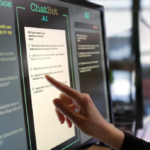Currently, the dynamic partnership between humans and machines is reshaping job opportunities. In this era of rapid technological advancement, understanding the synergy between our skills and the capabilities of machines is paramount.
This article explores the evolving landscape of employment, exploring how collaboration, rather than competition, improves many enhanced job opportunities.
As we jump on this exciting journey, it becomes clear that embracing this union is not just a choice but a necessity for those seeking to thrive in the ever-changing world of work.
Evolution of Work in Recent Years
Work has changed over time, like a story unfolding through the ages. The begInitiallyoiled in fields and workshops, shaping the world with their hands. Then came the Industrial Revolution, bringing machines that powered factories and transformed our work.
Fast forward to today, and we find ourselves in the digital age. Computers and technology have become our companions in the workplace, altering the landscape once again. This evolution isn’t just about the tools we use; it’s a shift in approaching tasks and challenges.
Automation, a word buzzing in the air, has taken center stage. Machines now handle repetitive tasks, leaving humans more room to think, create, and innovate. While some worry about jobs disappearing, history shows us that every change brings new opportunities.
The journey continues, with work evolving into a dance between human ingenuity and machine precision. Jobs that once seemed mundane are now infused with technology, creating a synergy that boosts productivity and efficiency.
This evolution isn’t just about survival; it’s about thriving in a world where collaboration between humans and machines defines success as we explore this journey through time, not only the changes and work but also the boundless opportunities that arise when humans and machines join forces in the ever-evolving narrative of employment.
The Role of Machines
In today’s world, machines are vital in getting things done. Imagine them as helpful companions in repetitive tasks. These machines are like brilliant colleagues who excel at handling data, crunching numbers, and performing tasks accurately beyond human capability.
Take manufacturing, for example. Machines on the factory floor tirelessly assemble products, ensuring speed, speeding up access, reducing errors, and making products more reliable.
Healthcare benefits, too. Machines assist doctors in diagnosing illnesses, analyzing vast amounts of data, and saving time, and leads can also lead to more accurate and timely treatments, improving patient outcomes.
Financial institutions also lean on machines. They navigate complex calculations and transactions swiftly, ensuring the integrity of financial systems. This benefits businesses and individuals relying on secure and prompt financial services.
The role of machines isn’t about replacing humans; it’s about enhancing what we can achieve together. They handle the heavy lifting, freeing us to focus on tasks that require creativity, critical thinking, and emotional intelligence – areas where machines may lack finesse.
So, as we navigate this technological landscape, it’s essential to embrace the complementary role of machines in our work. Together, humans and machines create a symphony of efficiency, ensuring each contributes unique strengths to the ever-evolving world of tasks and opportunities.
Best Humanin Demand
These human skills are not just valuable; they’re essential in the evolving world of work. Here’s a list of these in-demand human skills:
Emotional Intelligence
Understanding emotions, both our own and others, sets humans apart. This emotional intelligence allows for effective communication, collaboration, and empathy – vital elements in workplaces and industries that value human connections.
Critical Thinking
Machines excel at processing information, but humans bring critical thinking. We can analyze, evaluate, and make decisions based on a combination of logic and intuition, navigating the nuances that escape the binary world of machines.
Complex Problem Solving
Humans thrive on solving intricate puzzles and navigating complex scenarios. This skill becomes invaluable in industries facing challenges that require a nuanced and multifaceted approach.
Communication Skills
Effective communication is a cornerstone of human interaction. From articulating ideas to actively listening, humans excel in conveying information in ways that are nuanced, context-aware, and tailored to diverse audiences.
Teamwork and Collaboration
While machines can perform tasks individually, humans shine in collaborative settings. Teamwork involves understanding diverse perspectives, leveraging collective strengths, and achieving shared goals – a uniquely human quality.
Leadership
Human leaders inspire, guide, and motivate teams. Leadership goes beyond just giving commands; it involves emotional intelligence, strategic thinking, and the ability to foster a positive and productive work environment.
Ethical Decision-Making
Machines operate on algorithms, but ethical decision-making requires a human touch. Considering the broader societal impact and ethical implications of decisions is a responsibility that falls on human shoulders.
Curiosity
The innate human curiosity fuels a continuous quest for knowledge. It drives exploration, learning, and a desire to understand the world, fostering an environment of constant growth and improvement.
Interpersonal Skills
Building relationships and understanding others are essential interpersonal skills. Humans excel in creating meaningful connections and fostering a collaborative and supportive workplace atmosphere.
Time Management
Humans can manage time effectively, balancing multiple tasks and priorities. This skill ensures productivity and efficiency in a world where valuable resources are available.
Resilience
The ability to bounce back from challenges, adapt to change, and maintain a positive mindset is invaluable. Employers recognize that resilient individuals contribute to a thriving workplace, making it an essential quality sought after in professionals.
Cultural Intelligence
Understanding and navigating are increasingly crucial in a globalized world. Cultural intelligence allows for effective communication and collaboration across borders.
Best Ways for Humans and Machines to Partner for Job Opportunities
In the evolving work landscape, collaboration between humans and machines is not just a possibility; it’s necessary to unlock the full spectrum of job opportunities. Here are ten detailed ways in which humans and machines can seamlessly partner to enhance job prospects:
1. Identifying Complementary Strengths
Humans and machines have distinct strengths. Identify tasks where machines excel in efficiency and precision, allowing humans to focus on areas requiring creativity, critical thinking, and emotional intelligence.
2. Continuous Learning and Upskilling
Embrace a culture of continuous learning. Humans can upskill in areas where machines support them, such as learning to navigate and optimize automated systems, ensuring relevance and adaptability.
3. Human-Machine Collaboration Training
Implement training programs that specifically address how humans and machines can collaborate effectively. This ensures that individuals understand the strengths of both entities and optimize their workflows accordingly.
4. Integration of AI and Automation
Integrate AI and automation strategically. The integration of AI and automation represents a powerful synergy between humans and machine; transforming businesses create a harmonious partnership by harnessing AI’s strengths of AI for repetitive tasks antimonious partnership.
5. Using AI in Decision-Making
Use AI as a decision support tool. While machines can quickly process vast amounts of data, human intuition, and ethical considerations are crucial in making complex decisions.
6. Creating Cross-Functional Teams
Foster collaboration by creating cross-functional teams that include both humans and machines. This ensures diverse perspectives and a collective approach to problem-solving.
7. Emphasizing Soft Skills in Training
While technical skills are essential, emphasize the development of soft skills in training programs. Communication, teamwork, and adaptability remain critical in collaborative work environments.
8. Automating Routine Tasks
Identify routine and repetitive tasks that machines can handle, freeing up human resources for more engaging and complex responsibilities. This not only enhances job satisfaction but also overall productivity.
9. Encouraging Innovation Hubs
Establish innovation hubs where humans and machines collaborate on projects. These hubs can become hotbeds for creative ideas, with humans providing visionary concepts and machines aiding execution.
10. Feedback Loops for Continuous Improvement
Implement feedback loops to improve collaboration continuously. Regular assessments of human-machine workflows help identify areas for enhancement, ensuring an evolving and efficient partnership.
How iApply can Help in Partnering Humans and AI in Job Opportunities?
In the search for seamless collaboration between humans and AI in job opportunities, iApply emerges as a valuable choice. It facilitates a harmonious partnership. Here’s how iApply can play an important role:
1. Efficient Recruitment Process
iApply streamlines the recruitment process, leveraging AI to sift through resumes and identify potential candidates. This allows human recruiters to focus on personalized interactions and critical decision-making.
2. AI-Powered Skill Matching
iApply employs AI algorithms to match candidate skills with job requirements. This ensures a more accurate and efficient pairing, optimizing the potential for successful human-machine collaboration.
3. Personalized Learning Paths
With iApply, individuals can access personalized learning paths based on their career goals and industry demands. This promotes continuous learning, enabling humans to upskill in areas that complement AI capabilities.
4. Feedback and Performance Analysis
iApply provides insightful feedback and performance analysis. Humans can leverage this information to understand their strengths and areas for improvement, fostering a growth mindset in the ever-evolving job landscape.
5. Dynamic Job Recommendations
The platform offers dynamic job recommendations based on evolving industry trends and individual skills. This ensures that humans stay informed about emerging opportunities in collaboration with AI.
6. Collaborative Project Management
iApply facilitates collaborative project management, allowing humans and AI to work together on specific tasks. This hands-on experience fosters a deeper understanding of each other’s capabilities and enhances teamwork.
Conclusion:
In conclusion, the collaboration between humans and machines is not a futuristic concept—it’s the present reality shaping job opportunities. By supporting a symbiotic relationship, where humans contribute creativity and emotional intelligence and machines enhance efficiency, we pave the way for a dynamic and promising future.
In this collaborative journey, continuous learning, adaptability, and a focus on shared goals will be the guiding principles for thriving in the ever-evolving job market.









